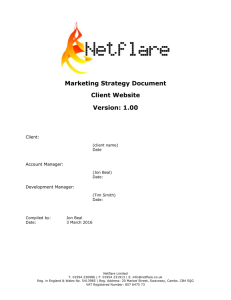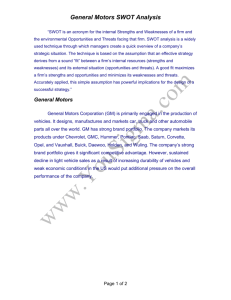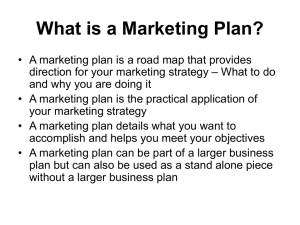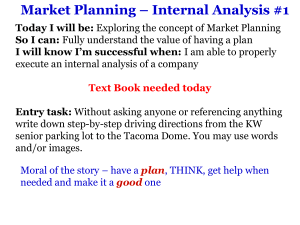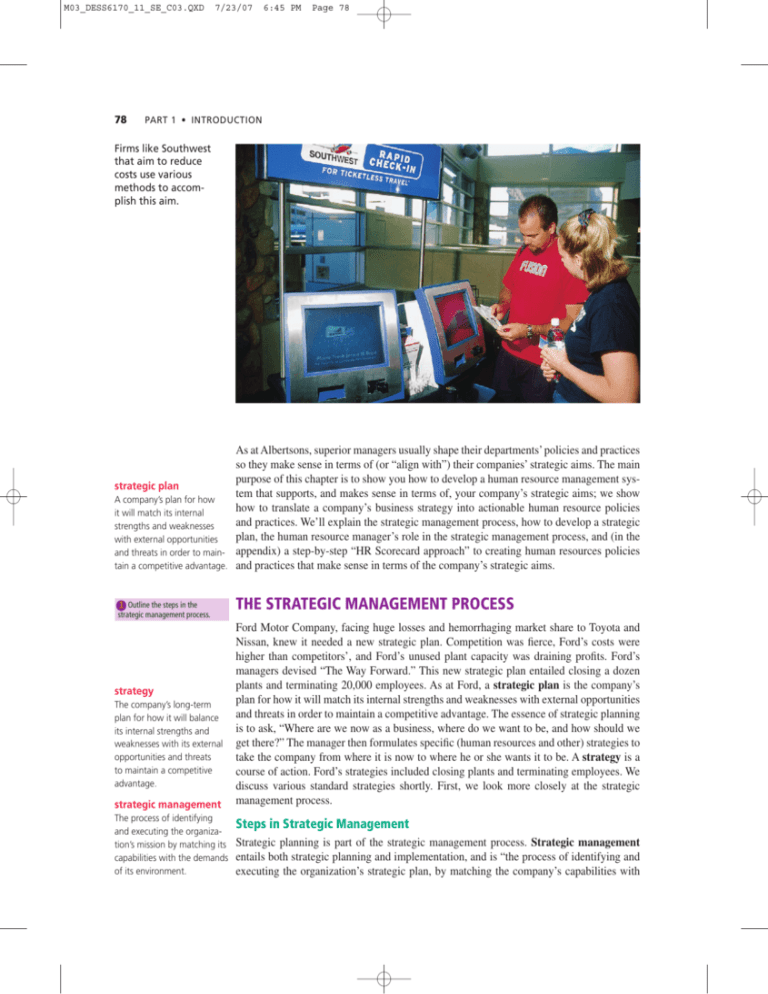
M03_DESS6170_11_SE_C03.QXD
78
7/23/07
6:45 PM
Page 78
PART 1 • INTRODUCTION
Firms like Southwest
that aim to reduce
costs use various
methods to accomplish this aim.
strategic plan
A company’s plan for how
it will match its internal
strengths and weaknesses
with external opportunities
and threats in order to maintain a competitive advantage.
1 Outline the steps in the
strategic management process.
strategy
The company’s long-term
plan for how it will balance
its internal strengths and
weaknesses with its external
opportunities and threats
to maintain a competitive
advantage.
strategic management
The process of identifying
and executing the organization’s mission by matching its
capabilities with the demands
of its environment.
As at Albertsons, superior managers usually shape their departments’ policies and practices
so they make sense in terms of (or “align with”) their companies’ strategic aims. The main
purpose of this chapter is to show you how to develop a human resource management system that supports, and makes sense in terms of, your company’s strategic aims; we show
how to translate a company’s business strategy into actionable human resource policies
and practices. We’ll explain the strategic management process, how to develop a strategic
plan, the human resource manager’s role in the strategic management process, and (in the
appendix) a step-by-step “HR Scorecard approach” to creating human resources policies
and practices that make sense in terms of the company’s strategic aims.
THE STRATEGIC MANAGEMENT PROCESS
Ford Motor Company, facing huge losses and hemorrhaging market share to Toyota and
Nissan, knew it needed a new strategic plan. Competition was fierce, Ford’s costs were
higher than competitors’, and Ford’s unused plant capacity was draining profits. Ford’s
managers devised “The Way Forward.” This new strategic plan entailed closing a dozen
plants and terminating 20,000 employees. As at Ford, a strategic plan is the company’s
plan for how it will match its internal strengths and weaknesses with external opportunities
and threats in order to maintain a competitive advantage. The essence of strategic planning
is to ask, “Where are we now as a business, where do we want to be, and how should we
get there?” The manager then formulates specific (human resources and other) strategies to
take the company from where it is now to where he or she wants it to be. A strategy is a
course of action. Ford’s strategies included closing plants and terminating employees. We
discuss various standard strategies shortly. First, we look more closely at the strategic
management process.
Steps in Strategic Management
Strategic planning is part of the strategic management process. Strategic management
entails both strategic planning and implementation, and is “the process of identifying and
executing the organization’s strategic plan, by matching the company’s capabilities with
M03_DESS6170_11_SE_C03.QXD
7/23/07
6:45 PM
Page 79
CHAPTER 3 • STRATEGIC HUMAN RESOURCE MANAGEMENT AND THE HR SCORECARD
Step 1:
Define the
current
business
and
mission
Step 2:
Perform
external
and
internal
audits
Step 3:
Formulate
new
business
and mission
statements
Strategic Planning
Step 4:
Translate
the
mission
into
goals
Step 5:
Formulate
strategies to
achieve the
strategic
goals
79
Step 6:
Implement
the
strategy
Step 7:
Evaluate
performance
Strategic
Execution
Strategic
Evaluation
FIGURE 3-1
The Strategic Management Process
the demands of its environment.” Strategic planning comprises (see Figure 3-1) the first 5
of 7 strategic management tasks: (1) defining the business and developing a mission,
(2) evaluating the firm’s internal and external strengths, weaknesses, opportunities, and
threats, (3) formulating a new business statement, (4) translating the mission into strategic
goals, and (5) formulating strategies or courses of action. In its simplest sense, however,
strategic planning is remarkably simple: Decide what business you’re in now and which
ones you want to be in, formulate a strategy for getting there, and execute your plan. The
entire 7-step strategic management process follows:
vision
A general statement of its
intended direction that
evokes emotional feelings
in organization members.
Step 1: Define the Current Business Every company must choose the terrain on
which it will compete—in particular, what products it will sell, where it will sell
them, and how its products or services will differ from its competitors’. Rolex
and Seiko are both in the watch business, but Rolex sells a limited product line of
high-priced quality watches. Seiko sells a wide variety of relatively inexpensive
but innovative specialty watches with features like compasses and altimeters.
Therefore, the most basic strategic decisions managers make involve
deciding “what business” their firms should be in: For instance, in terms of the
products or services they’ll sell, the geographic locales in which they’ll sell
them, and how they’ll distinguish their products or services from competitors’.
They ask, “Where are we now in terms of the business we’re in, and what business do we want to be in, given our company’s opportunities and threats, and
its strengths and weaknesses?” Managers then choose strategies—courses of
action such as buying competitors or expanding overseas—to get the company
from where it is today to where it wants to be tomorrow.
Managers sometimes use a vision statement as a sort of shorthand to summarize how they see the business down the road. The company’s vision is a
general statement of its intended direction that shows, in broad terms, “what we
want to become.”2 Rupert Murdoch, chairman of News Corporation (which
owns MySpace.com, the Fox network, and many newspapers and satellite TV
operations), has a vision of an integrated, global satellite-based news-gathering,
entertainment, and multimedia firm. WebMD launched its business based on
a vision of a Web site supplying everything one might want to know about
medical-related issues. One eye care company says, “our vision is caring for
your vision.”3 Not surprisingly, it helps to be something of a visionary to
formulate a vision statement that sums up in just a few words the manager’s
M03_DESS6170_11_SE_C03.QXD
80
7/23/07
6:45 PM
Page 80
PART 1 • INTRODUCTION
image of where the business is heading. Two management gurus, Warren Bennis
and Bert Manus say,
To choose a direction, a leader must first have developed a mental image
of a possible and desirable future state for the organization. This image,
which we call a vision, may be as vague as a dream or as precise as a goal
or mission statement. The critical point is that a vision articulates a view
of a realistic, credible, attractive future for the organization, a condition
that is better in some important ways than what now exists.4
mission
Spells out who the company
is, what it does, and where
it’s headed.
SWOT analysis
The use of a SWOT chart to
compile and organize the
process of identifying company Strengths, Weaknesses,
Opportunities, and Threats.
Visions are usually longer term, broader images; most managers also formulate
mission statements to “. . . communicate ‘who we are, what we do, and where we’re
headed.’”5 Whereas visions usually lay out in very broad terms what the business
should be, the mission lays out in broad terms what our main tasks are now. In the
movie several years ago, “Saving Private Ryan,” the team’s mission was, of course,
to save private Ryan. Before their more recent turndown, Ford pursued and then
strayed from a remarkably successful mission, summed up by the phrase, “Where
Quality is Job One.” The mission of the California Energy Commission is to “assess, and act through public/private partnerships to improve energy systems that
promote a strong economy and a healthy environment.” (The Commission’s vision,
by way of comparison, is “for Californians to have energy choices that are affordable, reliable, diverse, safe, and environmentally acceptable.”)
Step 2: Perform External and Internal Audits Ideally, managers begin their strategic
planning by methodically analyzing their external and internal situations. The
strategic plan should provide a direction for the firm that makes sense, in terms
of the external opportunities and threats the firm faces and the internal strengths
and weaknesses it possesses. To facilitate this strategic external/internal audit,
many managers use SWOT analysis. This involves using a SWOT chart like
that in Figure 3-2 to compile and organize the process of identifying company
Strengths, Weaknesses, Opportunities, and Threats.
Step 3: Formulate New Business and Mission Statements Based on the situation
analysis, what should our new business be, in terms of what products it will
sell, where it will sell them, and how its products or services will differ from its
competitors’? What is our new mission and vision?
Step 4: Translate the Mission into Strategic Goals Saying the mission is “to make
quality job one” is one thing; operationalizing that mission for your managers
is another. The firm’s managers need strategic goals. What exactly does that
mission mean, for each department, in terms of how we’ll boost quality? As an
example, WebMD’s sales director needs goals regarding the number of new
FIGURE 3-2
Strengths
Weaknesses
A SWOT Chart
Example: strong
research group
Example: aging
machinery
Opportunities
Threats
Example:
expanding
China markets
Example: merger
of two competitors
to form single
strong one
M03_DESS6170_11_SE_C03.QXD
7/23/07
6:45 PM
Page 81
CHAPTER 3 • STRATEGIC HUMAN RESOURCE MANAGEMENT AND THE HR SCORECARD
strategic control
The process of assessing
progress toward strategic
goals and taking corrective
action as needed.
81
medical-related content providers—vitamin firms, hospitals, HMOs—it must
sign up per year, as well as sales revenue targets. The business development
manager needs goals regarding the number of new businesses—such as using
WebMD to help manage doctors’ offices online—he or she is to develop and
sign. Similarly, Citicorp can’t function solely with a mission like, “provide integrated, comprehensive financial services worldwide.” To guide managerial
action, it needs goals in terms of things like building shareholder value, maintaining superior rates of return, building a strong balance sheet, and balancing
the business by customer, product, and geography.6
Step 5: Formulate Strategies to Achieve the Strategic Goals Again, a strategy is a
course of action. It shows how the enterprise will move from the business it is
in now to the business it wants to be in (as laid out by its vision, mission, and
strategic goals), given the firm’s opportunities, threats, strengths, and weaknesses. The strategies bridge where the company is now, with where it wants
to be tomorrow. The best strategies are concise enough for the manager to express
in an easily communicated phrase that resonates with employees. Figure 3-3
illustrates “this principle.” For example, the essence of Dell’s strategy is, “be
direct.” Wal-Mart’s strategy boils down to “low prices, every day.”
Keeping the strategy clear and concise helps ensure that employees all share
that strategy and so make decisions that are consistent with it. For example, the
executive team’s shared understanding of Nokia’s strategy reportedly helps explain how the firm can make thousands of decisions each week so coherently.7
Step 6: Implement the Strategies Strategy implementation means translating the
strategies into actions and results—by actually hiring (or firing) people, building (or closing) plants, and adding (or eliminating) products and product lines.
Strategy implementation involves drawing on and applying all the management
functions: planning, organizing, staffing, leading, and controlling.
Step 7: Evaluate Performance Strategies don’t always succeed. For example,
Procter & Gamble announced it was selling its remaining food businesses—Jif,
Crisco, and Folger’s coffee—because management wants to concentrate on
household and cosmetics products.8
Managing strategy is an ongoing process. Competitors introduce new
products, technological innovations make production processes obsolete, and
social trends reduce demand for some products or services while boosting demand
for others. Strategic control keeps the company’s strategy up to date. It is
Company
Strategic Principle
Dell
eBay
General Electric
Southwest Airlines
Vanguard
Wal-Mart
Be direct
Focus on trading communities
Be number one or number two in every industry in which we compete, or
get out
Meet customers’ short-haul travel needs at fares competitive with the cost
of automobile travel
Unmatchable value for the investor-owner
Low prices, every day
FIGURE 3-3
Strategies in a Nutshell
Source: Arit Gadiesh and James Gilbert, “Frontline Action,” Harvard Business Review, May 2001, p. 74.
Copyright © 2001 by the Harvard Business School Publishing Corporation; all rights reserved.




